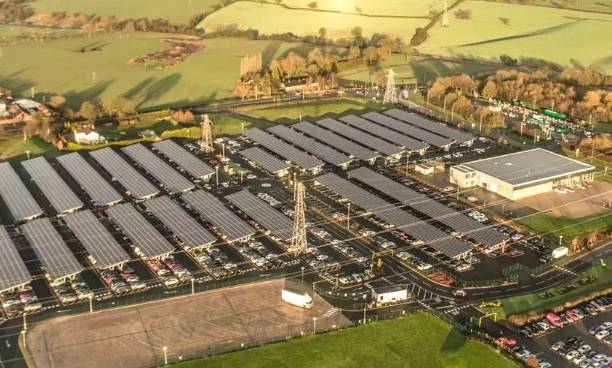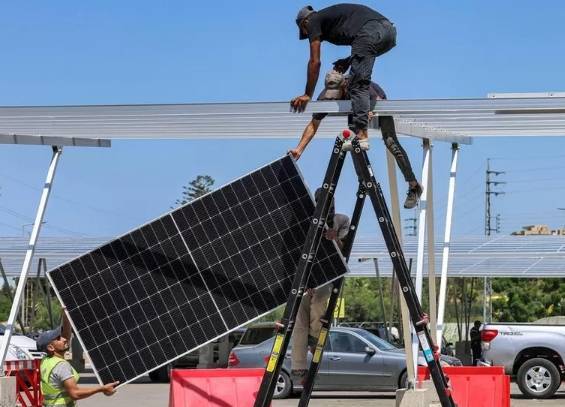This car park offers more than just parking spaces and vehicles. It showcases vast arrays of tilted solar panels mounted on sleek black steel supports, harnessing the power of the sun while providing shade for the parked cars below.
Adjacent to the offices of a prominent car manufacturer in southern England, an impressive installation of over 2,000 solar panels has taken shape, boasting a combined peak capacity of nearly 1 megawatt (MW). This sustainable energy solution has the potential to provide electricity to numerous households.
According to Guy Chilvers, the business development manager at SIG, the supplier of the solar canopies, the aesthetics of these structures are truly remarkable. He emphasizes that these solar canopies enhance the visual appeal of car parks, although he acknowledges his bias, stating, “I would say that.”
Solar car parks or car ports provide an opportunity for electricity generation in open areas strategically located near energy-intensive facilities like hospitals, shopping centers, or offices. These canopies offer added advantages as they shield vehicles from inclement weather conditions such as rain, snow, or excessive heat during summer.
In an effort to promote clean energy generation, the French Senate has recently passed a law mandating the installation of solar panels on all existing and new car parks with 80 or more spaces. Although the UK does not have a similar requirement, solar car parks have been in existence for several years, and there are indications of their growing popularity. With electricity prices remaining high, many businesses are embracing on-site renewable energy sources to reduce costs over the long term.
A recent report by the countryside charity CPRE and the UCL Energy Institute highlights a significant opportunity to transform British car parks into solar farms. According to Professor Mark Barrett from UCL, the report estimates a total potential of approximately 117GW in the built environment, with around 11GW attributed to car parks. This emphasizes the substantial untapped potential for solar energy generation in the car park sector.

Guy Chilvers, pictured on the left with a colleague, expresses that the demand for this framework has skyrocketed
To provide context, Solar Energy UK states that the current total solar capacity in the UK stands at approximately 15GW. However, in order to achieve net-zero targets by 2030, the country needs to reach a capacity of 40GW. Considering this, Professor Barrett emphasizes that the estimated 11GW potential from car parks is a conservative figure. The estimate is based on the assumption of 130 square kilometers of available car parks in the UK, which is lower than the 200 square kilometers estimated by estate agents Knight Frank. Furthermore, the report by CPRE and UCL assumes that only 50% of each individual car park would be covered by solar canopies, rather than the full 100%.
The potential for solar panels in car parks is becoming increasingly evident, and the demand for such installations is on the rise. Mr. Chilvers describes the situation as “absolutely gone crazy,” as he receives numerous inquiries in his inbox. He now finds himself providing quotes for various establishments like hotels, hospitals, and leisure centers. Mr. Chilvers and his team specialize in designing and constructing the steel structures for solar canopies, while the panels themselves are supplied separately.
Other companies in the industry have also reported a significant increase in demand for solar car park canopies. Praxia Energy, a Spain-based company, currently supplies around 3MW of car park solar installations in the UK annually. However, they anticipate that this figure will expand tenfold by 2028, reflecting the growing popularity and adoption of solar energy solutions.
According to a spokeswoman from Veolia, the company has recently completed the installation of a 1.1MW solar canopy system in the car park of Eastbourne Hospital. They have witnessed a surge in demand for solar infrastructure in the UK. Similarly, Solarsense, a Clevedon-based company, has experienced a notable increase in inquiries over the past few months. The growing interest in solar energy solutions is evident across various sectors.

According to Tim Evans, the CEO of 3ti, the UK has been slower than its European counterparts in adopting solar car park technology. He believes that the country has some catching up to do. However, there are already notable examples that showcase the potential of this technology. The largest solar car park in the UK can be found at the Bentley car factory in Crewe, boasting a peak capacity of 2.7MW. These flagship installations serve as a testament to the possibilities of solar energy in car parks.
Mr. Evans reveals that he is actively considering four new projects with clients that have the potential to exceed a peak capacity of 5MW. Solar panels installed in car parks not only generate electricity but also have the added advantage of powering electric vehicle (EV) charging stations. This application is particularly effective in office settings where employees’ cars are parked for extended periods. Additionally, shopping centers, football stadiums, leisure centers, and cinemas are ideal locations for solar car parks as vehicles are typically parked for two hours or more, allowing ample time for charging, according to Mr. Evans.
However, the inclusion of steel supports for solar canopies does increase the overall cost. In many cases, it is more cost-effective to install solar panels directly on the roofs of large buildings, such as supermarkets. According to Mr. Evans, rooftop solar installations currently yield electricity at approximately 9p per kWh, whereas solar panels in car parks can cost around 14p or 15p per kWh. Richard Watkins, from the University of Kent, points out that there aren’t many other obvious drawbacks to using canopies. However, he suggests that installers might consider incorporating efficient under-canopy lighting to prevent the spaces from becoming dark and potentially hazardous during nighttime.

Many renewable energy projects are currently facing a hurdle due to the insufficient availability of grid connections. This issue arises because surplus energy generated by sources like solar panels needs to be accommodated by the grid. BBC research suggests that billions of pounds worth of renewable installations are in a state of limbo as a result. Mr. Chilvers expresses his frustration, stating that he recently encountered a situation where a splendid one-megawatt car park designed for a factory was rejected solely due to the unavailability of a grid connection.
The issue of grid connections is acknowledged by a spokesperson from Solar Energy UK, who emphasizes that the widespread adoption of solar car parks will remain a distant possibility until this challenge is addressed. To tackle this problem, the energy industry regulator, Ofgem, is actively exploring avenues to expedite connections. Additionally, National Grid has devised a plan to enhance the connection process, recognizing the need for improvements in this area.
According to Prof Sara Walker from Newcastle University, there are numerous other areas across the UK, apart from car parks, that have the potential to host solar installations and contribute to our transition away from fossil fuels. Examples include cycle paths, railways, and reservoirs that can be covered with floating solar panels. Implementing solar panels in such locations not only generates clean energy but also helps to mitigate water evaporation from reservoirs. Prof Walker emphasizes the advantage of co-locating solar photovoltaics with existing infrastructure, such as car parks, as it allows for dual utilization of the land surface, maximizing its efficiency and sustainability.



